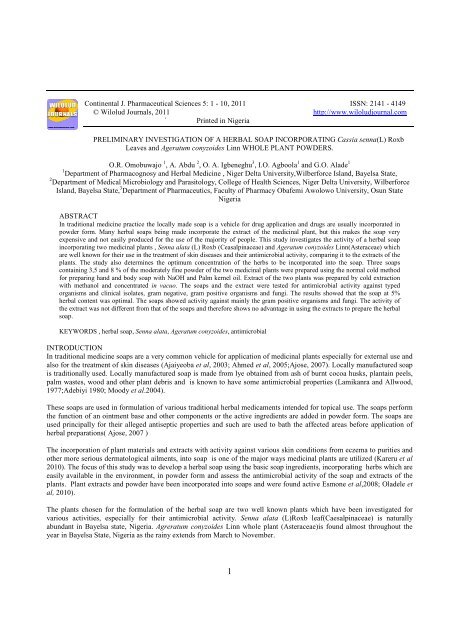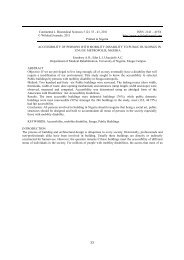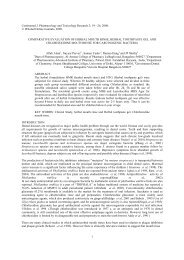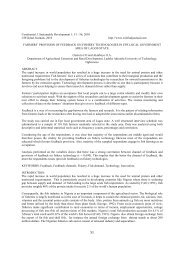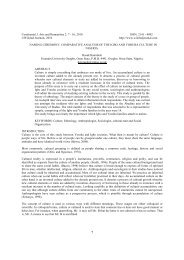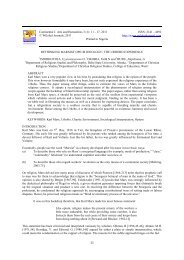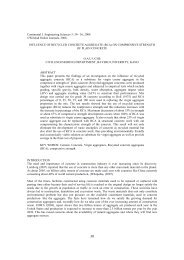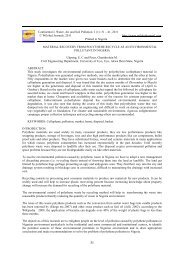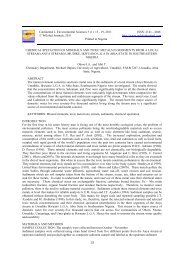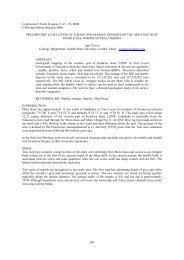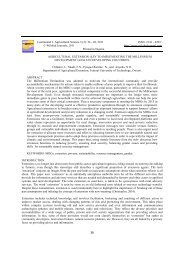Vol 5 _1_ - Cont. J. Pharm Sci. - Wilolud Journals
Vol 5 _1_ - Cont. J. Pharm Sci. - Wilolud Journals
Vol 5 _1_ - Cont. J. Pharm Sci. - Wilolud Journals
You also want an ePaper? Increase the reach of your titles
YUMPU automatically turns print PDFs into web optimized ePapers that Google loves.
<strong>Cont</strong>inental J. <strong>Pharm</strong>aceutical <strong>Sci</strong>ences 5: 1 - 10, 2011 ISSN: 2141 - 4149© <strong>Wilolud</strong> <strong>Journals</strong>, 2011 http://www.wiloludjournal.com` Printed in NigeriaPRELIMINARY INVESTIGATION OF A HERBAL SOAP INCORPORATING Cassia senna(L) RoxbLeaves and Ageratum conyzoides Linn WHOLE PLANT POWDERS.O.R. Omobuwajo 1 , A. Abdu 2 , O. A. Igbeneghu 3 , I.O. Agboola 1 and G.O. Alade 11 Department of <strong>Pharm</strong>acognosy and Herbal Medicine , Niger Delta University,Wilberforce Island, Bayelsa State,2 Department of Medical Microbiology and Parasitology, College of Health <strong>Sci</strong>ences, Niger Delta University, WilberforceIsland, Bayelsa State, 3 Department of <strong>Pharm</strong>aceutics, Faculty of <strong>Pharm</strong>acy Obafemi Awolowo University, Osun StateNigeriaABSTRACTIn traditional medicine practice the locally made soap is a vehicle for drug application and drugs are usually incorporated inpowder form. Many herbal soaps being made incorporate the extract of the medicinal plant, but this makes the soap veryexpensive and not easily produced for the use of the majority of people. This study investigates the activity of a herbal soapincorporating two medicinal plants , Senna alata (L) Roxb (Ceasalpinaceae) and Ageratum conyzoides Linn(Asteraceae) whichare well known for their use in the treatment of skin diseases and their antimicrobial activity, comparing it to the extracts of theplants. The study also determines the optimum concentration of the herbs to be incorporated into the soap. Three soapscontaining 3,5 and 8 % of the moderately fine powder of the two medicinal plants were prepared using the normal cold methodfor preparing hand and body soap with NaOH and Palm kernel oil. Extract of the two plants was prepared by cold extractionwith methanol and concentrated in vacuo. The soaps and the extract were tested for antimicrobial activity against typedorganisms and clinical isolates, gram negative, gram positive organisms and fungi. The results showed that the soap at 5%herbal content was optimal. The soaps showed activity against mainly the gram positive organisms and fungi. The activity ofthe extract was not different from that of the soaps and therefore shows no advantage in using the extracts to prepare the herbalsoap.KEYWORDS , herbal soap, Senna alata, Ageratum conyzoides, antimicrobialINTRODUCTIONIn traditional medicine soaps are a very common vehicle for application of medicinal plants especially for external use andalso for the treatment of skin diseases (Ajaiyeoba et al, 2003; Ahmed et al, 2005;Ajose, 2007). Locally manufactured soapis traditionally used. Locally manufactured soap is made from lye obtained from ash of burnt cocoa husks, plantain peels,palm wastes, wood and other plant debris and is known to have some antimicrobial properties (Lamikanra and Allwood,1977;Adebiyi 1980; Moody et al.2004).These soaps are used in formulation of various traditional herbal medicaments intended for topical use. The soaps performthe function of an ointment base and other components or the active ingredients are added in powder form. The soaps areused principally for their alleged antiseptic properties and such are used to bath the affected areas before application ofherbal preparations( Ajose, 2007 )The incorporation of plant materials and extracts with activity against various skin conditions from eczema to purities andother more serious dermatological ailments, into soap is one of the major ways medicinal plants are utilized (Kareru et al2010). The focus of this study was to develop a herbal soap using the basic soap ingredients, incorporating herbs which areeasily available in the environment, in powder form and assess the antimicrobial activity of the soap and extracts of theplants. Plant extracts and powder have been incorporated into soaps and were found active Esmone et al,2008; Oladele etal, 2010).The plants chosen for the formulation of the herbal soap are two well known plants which have been investigated forvarious activities, especially for their antimicrobial activity. Senna alata (L)Roxb leaf(Caesalpinaceae) is naturallyabundant in Bayelsa state, Nigeria. Agreratum conyzoides Linn whole plant (Asteraceae)is found almost throughout theyear in Bayelsa State, Nigeria as the rainy extends from March to November.1
O.R. Omobuwajo et al.,: <strong>Cont</strong>inental J. <strong>Pharm</strong>aceutical <strong>Sci</strong>ences 5: 1 - 10, 2011These two plants have been well researched by many workers and therefore qualified to be used in formulations of herbaldrugs. There are pharmacopoeia standards set for Senna alata leaves in the Nigerian Herbal <strong>Pharm</strong>copoeia (NHP,2008)Senna alata is also in the French <strong>Pharm</strong>acopeia (Hennebelle et al,2009)Ageratum conyzoides is a plant on the second list of plants to be included in the second volume of the Nigerian Herbalpharmacopoeia(NHP,2008).Senna alata commonly called ringworm, ‘craw craw’ plant or candle stick plant used for dermatitis, eczema ringwormgonorrhea (Dalziel, 1937, Irvine, 1961) is found in the rain forest and savannah areas in both the southern and northernparts of Nigeria. It is common in villages, wastelands and clearings and chiefly in the forest regions of Nigeria(Adjanohoun, et al1991Senna alata leaf contains reduced anthraquinone; aloe-emodin, rhein glycoside and aloe-emodin glycoside (Rai,1978).Kaempferol 3- O-gentiobioside and aloe emodin were also obtained from the leaf(Hazni et al 2008). Twelve compoundswere isolated from C. alata, which were identified as chrysoeriol, kaempferol, quercetin, 5,7,4'-trihydroflavanone ,kaempferol-3-O-beta-D-glucopyranoside , kaempferol-3-O-beta-D-glucopyranosyl-(1-->6)-beta-D-glucopyranoside, 17-hydrotetratriacontane , n-dotriacontanol , n-triacontanol , palmitic acid ceryl ester, stearic acid , palmitic acid (Liu et al,2009). Assay of leaves for flavonoid content by Akinmoladun et al (2010) showed the leaves contained 275.16=/-1.62microg/ml quercetin equivalent and significant antioxidant activity. Cassiaindoline, an indole alkaloid was isolated fromSenna alata and showed anti-inflammatory activity (Villaseñor et al 2009). Methanolic extract of the leaves of Sennaalata exhibited inhibition against Methicillin Resistant Staphylococcus aureus. Chrysophanol, physcion and kaempferolhave also been isolated from the root of Senna alata (Fernand et al, 2008).Senna alata leaves have shown antimicrobial and laxative activities (Elujoba et al 1989). The leaf and flower of S. alatashowed antimicrobial activity on unspecified Gram-positive bacteria and against Trichophyton rubrum and Basidiobolushaptosporus. Oil extracted from the leaf had inhibitory effects on Gram-positive and Gram-negative bacteria includingPseudomonas sp., Staphylococcus aureus and Escherichia coli (Ogunti et al 1991).Leaf extracts against were active againstPropionibacterium acnes, and Staphylococcus epidermidis which are the organisms implicated in acne (Chomnawang etal, 2005).Other investigations showed leaf extract to be active against Trichophyton tonsurans Microsporum soudanenseand more active than griseovulvin and clotrimazole (Eja et al, 2009). Leaves have been used to treat dermatophilosisinfected animals and there was no recurrence (Ali- Emmanuel et al 2003).A. conyzoides is widely utilized in traditional medicine by various cultures worldwide, although applications vary byregion. It is used to treat pneumonia,wounds and burns (Durodola,1977). It has also been used as a bacteriocide,antidysenteric, and antilithic (Borthakur and Baruah. 1987). It is used to treat fever, rheumatism, headache, and colic(Menut,1993; Vera, 1993) . A. conyzoides has quick and effective action in burn wounds and is recommended byBrazilian Drugs Central as an antirheumatic (Brasil, Ministério da Saúde, Central de Medicamentos, 1989; Akinyemi et al2005 ; Lans, 2007)Flavonoids, alkaloids, coumarins, tannins and essential oils have been obtained from A conyzoides. (Jaccoud,1961;Oliveira et al 1993.) Compounds which have been isolated from A conyzoides are conyzorigum, a cromene (Borthakur andBaruah. 1987), precocene I and precocene II, which have been shown to affect insect development, as antijuvenilehormones, resulting in sterile adults (Ekundayo et al, 1988).Other compounds, flavones, ageconyflavones A,B,C,hexamethoxy flavone, cumarinic compounds including 1-2 benzopirone and alkaloids of the pirrolizidinic group have beenisolated( Trigo et al, 1988). 51 terpenoid compounds were identified from volatile oil from A.conyzoides, includingprecocene I and precocene II (Gonzales, 1991.)11 cromenes in the essential oils, including 6-angeloyloky-7-methoxy-2,2-dimethylcromene were identified (Vera, 1993). Ageratocromene, and beta cariophylene were also obtained from Aconyzoides (Horie et al, 1993). Ether and chloroform extracts of the plant had inhibitory activity against Bacillus subtilis,Staphylococus aureus, Escheriachia coli and Pseudomonas aeruginosa (Almagboul et al 1985). Aqueous extracts showedanalgesic action and whole plant extracts had muscle relaxing activities (Achola et al, 1994).2
O.R. Omobuwajo et al.,: <strong>Cont</strong>inental J. <strong>Pharm</strong>aceutical <strong>Sci</strong>ences 5: 1 - 10, 2011MATERIALS AND METHODSPlant CollectionSenna alata leaves were collected from the Department of <strong>Pharm</strong>acognosy and Herbal Medicine, Niger Delta University,Nigeria, medicinal plant garden. The leaves were air dried for a few days and then ground. The powder stored in wellsealed containers away from light for further use.Ageratum conyzoides was collected from the grounds of the College of Health <strong>Sci</strong>ences, Niger Delta University, Nigeria.The soil was removed from the roots and washed with distilled water. The whole herb was air dried for a few days andground and stored in well sealed containers and stored away from light for further use.Plant PowderThe Plant material to be introduced was sieved to give a moderately fine powder according to the definition in the Qualitycontrol methods for medicinal plant materials by WHO. All particles will pass through a No. 355 sieve(Nominal aperturesize 0.355mm) and not more than 40% through a No. 108 sieve Nominal aperture size 0.180mm). After obtaining the gradeof powder desired, the powdered plant materials were weighed in equal amounts. The two plant materials were then siftedtogether to mix completely. The amount to be put into the soap mixture was then weighed out.Plant ExtractionOne hundred grams each of the two plant materials were weighed and extracted successively for 72 hours in the cold withmethanol. The extract was filtered and the extract concentrated in vacuo at room temperature using a rotary evaporator.The extract was stored at 4 o C till needed.Soap MaterialsPalm kernel oil (Pko)was obtained from local producers in the Osun State, Nigeria as the one obtained, locally in BaylesaState Yenagoa, Nigeria was full of burnt debris.Water – distilled waterNaOH- BDH analytical qualityMethodologyThe following soap formula was used to make a normal hand and body soap. This was scaled down to produce laboratorysize.2.3 liters of Pko0.36kg of NaOH0.9 liters of WaterThe cold method of soap making was used to prepare the herbal soap. The NaOH was dissolved in the water in a beakerand allowed to cool, poured gradually into the oil with continuous stirring. The plants materials were added gradually withstirring with a glass rod and the mixture was then poured into a rectangular pan and left to set.Soap containing three different percentages of plant material 3, 5 and 8%w/w were produced. The soaps were cut intosquares of 5cm by 5cm for ease of handling.Antimicrobial assessmentThe three formulations of soap and the extracts of the two plants were subjected to anti microbial tests using gram negativeand gram positive organisms and fungi. Typed and pathogenic organisms were used.METHODOLOGYThe agar-dilution method for the determination of minimum inhibitory concentration of antimicrobial agents approved byCLSI was employed (CLSI 2008). 5g of the herbal soap was suspended and dispersed in 10ml of sterile distilled water toobtain a stock suspension containing 500mg/ml. From this stock, dilutions were made by adding 1ml of the suspension to9ml of sterile molten Mueller Hinton agar in Petri-dishes to obtain a plate containing the soap at a concentration of3
O.R. Omobuwajo et al.,: <strong>Cont</strong>inental J. <strong>Pharm</strong>aceutical <strong>Sci</strong>ences 5: 1 - 10, 201150mg/ml (50g/l) and allowed to set and harden. Similar dilutions were carried out to obtain plates containing the otherdifferent concentrations of the soap tested. Plates were prepared in duplicates and plates prepared without including thesoap were used for negative control tests. The set plates were dried in an oven at 60 o C for 15 minutes before inoculatingwith overnight broth culture of each bacterial test organisms using a multi-inoculator. Similar plates were prepared usingSarbouraud dextrose agar (SDA) for testing the fungi. Inoculated plates were incubated at 37 o C for bacteria and 25 o C forfungi for 72 hours. Plates were examined for growth to determine presence or absence of inhibition.RESULTS AND DISCUSSIONPlant extractionThe yield of extract was 9.8%w/w.Antimicrobial AssayThe formulation is active against Sa and Sc at 8%, 5%, and 3% but more potent at 5% ( Table 1), this indicates that there ispossible synergic action at this concentration, while at higher concentration the activity is low, this may be due toantagonistic activity.The formulation is more active against Gram positive bacterial (both typed and Clinical strains) and Fungi at theconcentration tested (Tables 2,3and 4). No activity was shown against Gram negative organisms. This is expected as gramnegative bacteria , particularly Ps. aeruginosa is known to be resistance to various antimicrobial agents(Quinn et al.1986).For B. subtilis the soap gave a different picture by being more active at 5% than 8% (Tables 3 and 4).Investigation by Esimone et al(2008) shows the antimicrobial effect of the soap formulated with ethanolic extract of Sennaalata exhibited excellent antimicrobial activity, activity was predominantly against Gram-positive organisams andooprtunistic yeast. Oladele et al (2010)incorporated the Senna alata leaf powder into the soap and used it to treat skininfection by Tinea versicolor and Tinea corporis It is clear from their study that the plant Senna alata is active againstorganisms that cause skin diseases. This study is incorporating the plant material itself and comparing this to the activity ofthe extract. The incorporation of plant material into soap is not new as this is normal procedure in traditional medicine.Plant materials are incorporated in the traditional soap known as ‘Black soap’.The study has shown a good method of determining the concentration of herbs which may be needed for the formulation ofa herbal antimicrobial soap. In this case the optimum concentration could be determined. The soap need not contain morethan 5%W/W of the herbs.There is no doubt that the soaps were active and showed antimicrobial activity against gram positive bacteria and fungi.This is a good development as it means that in formulating herbal soaps it is possible to incorporate the plant material andstill get the desired results. This has an important implication to the cost of producing herbal soaps which are known to beexpensive due to having to extract the plant materials using expensive solvents. This will no doubt reduce the cost ofproduction of the herbal soap, making it more assessable to majority of the populace. The rational for investigating thismethod of the use of herbs in soap is justified. Two medicinal plants well known for their activities are incorporated, thisgives a broader spectrum of activity. Also, it is seen that there could be possibilities of synergism which is good, but alsoantagonism could occur between compounds, which may cause problems of drug-drug interactions.CONCLUSIONFrom the antimicrobial assessment of the extract of the plants and the soaps the optimum percentage of the plant materialsto be used for the herbal soap was determined. Further investigations of the clinical use of the herbal soap with theincorporated plant materials in its crude form are still undergoing clinical trials.REFERENCESAchola, K.J., Munenge R.W., & Mwaura A.M. (1994). <strong>Pharm</strong>acological properties of root and aerial parts extracts ofAgeratum conyzoides on isolated ileum and heart. Fitoterapia, 65,322–325.Adebiyi, M.A. (1980). A study of chemical, Physical and Antibacterial Properties of Nigerian soft soaps ( Ose Dudu)(M.Phil. Thesis). University of Ife,Ile-Ife, Nigeria.4
O.R. Omobuwajo et al.,: <strong>Cont</strong>inental J. <strong>Pharm</strong>aceutical <strong>Sci</strong>ences 5: 1 - 10, 2011Ahmed, O.A., Odunukwe, N.N., Akinwale, O.P., Raheem, T.Y., Efienemokwu, C.E., Ogedengbe, O., & Salako, LA.(2005). Knowledge and practices of traditional birth attendants in prenatal services in Lagos State, Nigeria. Afr J Med Med<strong>Sci</strong>,34(1),55-58.Ajaiyeoba, E.O., Oladepo, O., Fawole, O.I., Bolaji, O.M., Akinboye, D.O., Ogundahunsi, O.A., Falade, C.O., Gbotosho,G.O., Itiola, O.A., Happi, T.C., Ebong, O.O., Ononiwu, I.M., Osowole, O.S., Oduola, O.O., Ashidi, J.S.,& Oduola,A.M.,(2003). Cultural categorization of febrile illnesses in correlation with herbal remedies used for treatment inSouthwestern Nigeria.J Ethnopharmacol, 85(2-3),179-85.Adjanohoun, E J., Ahyi,M. R. A., Ake Assi L., Dramane K., Elewude, J.A., Fadoju S.U., Gbile, Z.O., Goudote, E., JohnsonCLA., Keita,A., Morakinyo O., Ojewole J.A., Olatunji A.O.& Sofowora E.A., (1991).<strong>Cont</strong>ribution to Ethnobotanical andFloristic studies in Western Nigeria. Lagos, Nigeria: Organization of African Unity’s <strong>Sci</strong>entific Technical and ResearchCommission).Ajose, F.O. (2007).Some Nigerian plants of dermatologic importance. Int J Dermatol, 46, Suppl 1:48-55.Akinmoladun, A.C., Obuotor, E.M., & Farombi, E.O. (2010). Evaluation of antioxidant and free radical scavengingcapacities of some Nigerian indigenous medicinal plants. J Medicinal Food, 13(2),444-51.Ali-Emmanuel, N., Moudachirou, M., Akakpo, J.A., & Quetin-Leclercq, J. (2003).Treatment of bovine dermatophilosiswith Senna alata, Lantana camara and Mitracarpus scaber leaf extracts. J Ethnopharmacol,86 (2-3),167-71.Almagboul, A.Z., Farroq, A.A., & Tyagi, B.R. (1985). Antimicrobial activity of certain Sudanese plants used in folkloricmedicine: Screening for antibacterial activity, part II. Fitoterapia, 56,103–109.Borthakur, N., & Baruah, A.K.S. (1987). Search for precocenes in Ageratum conyzoides Linn.of North-East India. J.Indian Chem. Soc., 64,580–581.Brasil, Ministério da Saúde, Central de Medicamentos. (1989). Ageratum conyzoides. In: Programa de pesquisas de plantasmedicinais: Primeiros resultados. Brasília.Chomnawang,M.T., Surassmo, S., Nukoolkarn, V.S., Gritsanapan, W. (2005).Antimicrobial effects of Thai medicinalplants against acne-inducing bacteria. J Ethnopharmacol, 3,101(1-3),330-333.Cheryl, L. (2007). Ethnomedicines used in Trinidad and Tobago for reproductive problems Journal of Ethnobiology andEthnomedicine, 3:13. doi:10.1186/1746-4269-3-13.Dalziel,J.M. (1937).The Useful Plants of West Tropical Africa: London: Crown agents for the Overseas Governments.Durodola, J.J. (1977). Antibacterial property of crude extracts from herbal wound healing remedy AgeratumPlanta Med, 32,388–390.conyzoides.Eja, M.E., Arikpo, G.E., Enyi-Idoh, K.H., Etim, S.E.,& Etta, H.E. (2009). Efficacy of local herbal therapy in themanagement of dermatophytosis among primary school children in Cross River State, South-south Nigeria. Afr J Med Med<strong>Sci</strong>, 38(2),135-141.Ekundayo, O., Sharma, S., & Rao E.V. (1988). Essential oil of Ageratum conyzoides. Planta Med, 54,55–57.Elujoba, A.A., Ajulo, O.O.,& Iweibo,G.O.(1989). Chemical and Biological analyses of Nigerian Cassia species forlaxative activity J <strong>Pharm</strong>. Biomed. Anal, 7 (12), 1453 – 1457.Esimone C. O., Nworu C. S., Ekong U. S.,& Okereke B. C. (2008). Evaluation of the antiseptic properties of Cassia alatabasedherbal soap . The Internet Journal of Alternative Medicine. 6 ,15
O.R. Omobuwajo et al.,: <strong>Cont</strong>inental J. <strong>Pharm</strong>aceutical <strong>Sci</strong>ences 5: 1 - 10, 2011Gonzales, A.G., Thomas, G., & Ram, P. (1991). Chromenes form Ageratum conyzoides. Phytochemistry, 30,1137–1139.Hazni, H., Ahmad, N., Hitotsuyanagi, Y., Takeya, K.,& Choo, C.Y.( 2008).Phytochemical constituents from Cassia alatawith inhibition against methicillin-resistant Staphylococcus aureus (MRSA). Planta Med,74(15),1802-5.Hennebelle, T., Weniger, B., Joseph, H., Sahpaz, S., & Bailleul, F,. (2009). Senna alata. Fitoterapia, 80(7),85-93.Horie, T., Tominaga, H.,& Kawamura, Y., (1993). Revised structure of a natural flavone from Ageratum conyzoides.Phytochemistry, 32,1076–1077.Irvine, F.R. , (1961).Woody plants of Ghana : London: Oxford University Press Jaccoud, R.J.S. (1961). <strong>Cont</strong>ribuição parao estudo formacognóstico do Ageratum conyzoides L. Rev. Bras. Farm., 42(11/12),177–97.Kareru, P.G., Keriko, J.M., Kenji, G.M., Thiong’o, G.T., Gachanja, A.N.,& Mukiira, H.N. (2010). Antimicrobial activitiesof skincare preparations from plant extracts African Journal of Traditional, Complementary and Alternative Medicines,7, 3.Lamikanra, A.,& Allwood, M.E. (1977). Effects of polyethoxyalkyl phenols on the leakage of intracellular materials fromStaphylococcus aureus. J.Appl. Bacteriol, 42, 379-385.Liu, A., Xu, L., Zou, Z.,& Yang, S.(2009). Studies on chemical constituents from leaves of Cassia alata. Zhongguo ZhongYao Za Zh,34(7),861-3.Menut, C., Sharma, S., & Luthra, C., (1993). Aromatic plants of tropical central Africa, Part X Chemical compositionof essential oils of Ageratum houstonianum Mill. and Ageratum conyzoides L. from Cameroon. Flavour Fragrance J,8(1),1–4.Moody, J.O., Adebiyi, O.A., Adeniyi, B.A., (2004).Do Aloe vera and Ageratum conyzoides enhance the anti-microbialactivity of traditional medicinal soft soaps (Osedudu)? J Ethnopharmacol, 92(1),57-60.NHP (2008). The Nigeria Herbal <strong>Pharm</strong>acopoeia. First Edition: Abuja, Federal Republic of Nigeria: Federal Ministry ofHealth.Ogunti, E.O., Aladesanmi, J.A.,& Adesanya, S.A.(1991).Antibacterial activity of Cassia alata, Fitoterapia, 62, 537.Oladele, A. T., Dairo, B. A., Elujoba, A. A., & Oyelami A. O. (2010). Management of superficial fungal infections withSenna alata (“alata”) soap: A preliminary report. African Journal of <strong>Pharm</strong>acy and <strong>Pharm</strong>acology, 4(3),098-103.Oliveira, F., Akisue, M.K., & Garcia, L.O. (1993). Caracterização farmacognóstica da droga e do extrato fluído dementrasto, Ageratum conyzoides L. Lecta, 11(1),63–100.Oliver-Bep, B. (1986). Medicinal Plants in Tropical West Africa. London: Cambridge University PressQuinn, J. P., Dudek, E.J., & Divincenzo, C.A. (1986). Emergence of resistance to imipenem during therapy forPseudomonas aeruginosa infection, Infect Dis, 154,289-294.Rai, P.P. (1978).Anthracene derivatives in leaves and fruits of Cassia alata, Curr. <strong>Sci</strong>. 47(8) ,271-272.Trigo, J.R., Campos, S. & Pereira, A.M. (1988). Presença de alcalóides pirrolizidinicos em Ageratum conyzoides L. In:Simposio de Plantas Medicinais do Brasil p. 13.Sao Paulo,Brazil:Resumos.Vera, R. (1993). Chemical composition of the essential oil of Ageratum conyzoides L.(Asteraceae) from Reunion. FlavourFragrance J, 8,256–260.6
O.R. Omobuwajo et al.,: <strong>Cont</strong>inental J. <strong>Pharm</strong>aceutical <strong>Sci</strong>ences 5: 1 - 10, 2011Fernand, V. E., Dinh, T.D., Washington, S. J., Fakayode, S. O., Losso, J. N., van Ravenswaay, R. O. & Warner, I. M.(2008). Determination of <strong>Pharm</strong>acologically Active Compounds in Root Extracts of Cassia alata L. by use of HighPerformance Liquid Chromatography Talanta, 15, 74(4),896–902.Villaseñor, I.M., & Sanchez, A.C. (2009). Cassiaindoline, a new analgesic and anti-inflammatory alkaloid from Cassiaalata. Z Naturforsch C,64(5-6),335-8.Received for Publication: 05/02/2011Accepted for Publication: 14/03/2011Corresponding Author:O.R. OmobuwajoDepartment of <strong>Pharm</strong>acognosy and Herbal Medicine , Niger Delta University,Wilberforce Island, Bayelsa State, NigeriaE-mail: oomobuwa@yahoo.com7
O.R. Omobuwajo et al.,: <strong>Cont</strong>inental J. <strong>Pharm</strong>aceutical <strong>Sci</strong>ences 5: 1 - 10, 2011Table 1 Results of antimicrobial Assay of Crude Extracts and Herbal soap at 3,5,and 8% Herbal <strong>Cont</strong>entConcentration(g/L)025 0.50 1.00 10.00 20.00 40.00A Crude LeafExtractPs + + + + + -Ec + + + + + -Sa + + + - - -Sc + + + - - -Bs + + + + + +Bc + - - - - -B (8%) Ps + + + + + +Ec + + + + + -Sa + + - - - -Sc + + - - - -Bs + + + + + -Bc - - - - - -C (5%) Ps + + + + + -Ec + + + + + -Sa - - - - - -Sc + - - - - -Bs + + + + + -Bc - - - - - -D(3%) Ps + + + + + -Ec + + + + + -Sa + - - - - -Sc + + - - - -Bs + + + + - -Bc - - - - - -Key:Ps: Pseudomonas aeruginosa (ATCC 19429), Ec: Escherichia coli (NCTC 10416), Sa: Staphylococcus aureus (NCTC 6571), Sc: Staphylococcus aureus(Clinical isolates), Bs: Bacillus subtilis (NCTC 8326), Bc: Bacillus cereus (Clinical isolates).+: Growth observed, -: Inhibition8
O.R. Omobuwajo et al.,: <strong>Cont</strong>inental J. <strong>Pharm</strong>aceutical <strong>Sci</strong>ences 5: 1 - 10, 2011Table 2 Results of Antimicrobial Assay of Herbal soap against clinical isolates at 8% Herbal content8%Concg/LB(NCTC8326E(NCTC10416 PsS(NCTC6571 S(HR1S(ATC Cp(NCYC))(ATCC19429) )) S(04TW) S2 S3 C) 6)50 + + + - - - - - - -40 + + + - - - - - - -30 + + + - - - - - - -20 + + + - - - - - - -10 + + + - - - + - - -5 + + + - - - + + - -1 + + + - - - + + - +0.5 + + + + + - + + - +0.25 + + + + + - + + + +KEY: CLINICAL ISOLATES, B: B. subtilis, E: E. Coli, Ps: Pseudomonas aeruginosa, S(NCTC): Staphylococcus aureus, S(ATCC):Staphylococcus aureus, Cp: Candida pseudotropicalis. +: no inhibition (Growth observed), -: inhibited (MIC).Table 3 Results of Antimicrobial Assay of Herbal soap against clinical isolates at 5% Herbal content5%Concg/LB(NCTC8326E(NCTC10416 PsS(NCTC6571 S(HR1S(ATC Cp(NCYC))(ATCC19429) )) S(04TW) S2 S3 C) 6)50 - + + - - - - - - -40 - + + - - - - - - -30 - + + - - - - - - -20 - + + - - - - - - -10 - + + - - - + - - -5 + + + - - - + + - -1 + + + + + + + + - +0.5 + + + + + + + + + +0.25 + + + + + + + + + +KEY: CLINICAL ISOLATES, B: B. Subtilis, E: E. Coli, Ps: Pseudomonas aeruginosa, S(NCTC): Staphylococcus aureus, S(ATCC): Staphylococcus aureus,Cp: Candida pseudotropicalis. +: no inhibition (Growth observed), -: inhibited (MIC).9
O.R. Omobuwajo et al.,: <strong>Cont</strong>inental J. <strong>Pharm</strong>aceutical <strong>Sci</strong>ences 5: 1 - 10, 20113%Conc g/LTable 4: Results of Antimicrobial Assay of Herbal soap against clinical isolates at 3% Herbal contentS(NCTC6571) S(HR1) S(04TW) S2 S3 S(ATCC) Cp(NCYC6)B(NCTC8326) E (NCTC10416)Ps(ATCC19429)50 + + + - - - - - - -40 + + + - - - - + - -30 + + + - - - - + - -20 + + + - - - - + - -10 + + + - - - - + - -5 + + + - - - + + - -1 + + + + + + + + + +0.5 + + + + + + + + + +0.25 + + + + + + + + + +KEY: CLINICAL ISOLATES, B: B. Subtilis, E: E. Coli, Ps: Pseudomonas aeruginosa, S(NCTC): Staphylococcus aureus, S(ATCC): Staphylococcus aureus,Cp: Candida pseudotropicalis. +: no inhibition (Growth observed), -: inhibited (MIC).10


